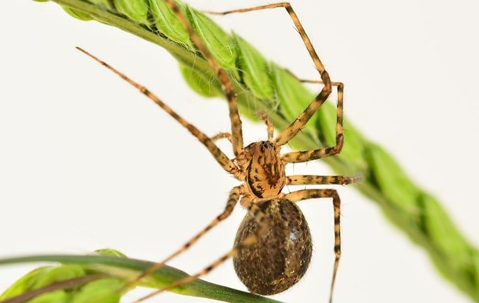Almost every home has house spiders. Would you be able to recognize a house spider if you saw one? We're willing to bet that you can't. There are three reasons. First of all, you have to know what we're referring to as a house spider. There are several species of spiders that are considered to be house spiders but only one species that is called "the" common house spider, known internationally as the American house spider. Second, the common house spider isn't often seen. This is because it tends to build multiple webs and abandon webs that aren't catching prey. You'll see a lot more webs than you'll see spiders. And, the common house spider, like most species of spider is nocturnal by nature. That is to say, they prefer to come out at night. So, you might not ever see these itsy bitsy spiders inside your Bettendorf home. Let's take a closer look at this and other spiders that are common in Bettendorf.
The Common House Spider
- This species of spider, which is known scientifically as Achaearanea tepidariorum, is 3/15 to 5/15 of an inch long (females) and ⅛ to 3/16 of an inch long (males). It is yellowish brown and has a dirty-looking abdomen. It is visually hairless and has eight legs.
Common house spiders create wispy, tangled webs in the upper corners of rooms, in still areas, storage rooms, underneath furniture, in the angles of window frames, and in wall voids. - While they are rarely seen out in the open, they don't have a problem being seen. In fact, they don't pay much attention to humans at all.
- Common house spiders are not known to bite but they may bite when threatened. Bites from house spiders are not considered medically important but you should seek medical attention if you notice severe swelling, a lesion, or you develop a headache.
- Common house spiders are becoming less common because they have a hard time surviving in modern homes with humidity controls.
Other Common House Spiders
There are many spiders that commonly get into Bettendorf homes. Some prefer to hang out in cellars and are also called cellar spiders. The daddy long-legs spider is a well known cellar spider that needs no description. Its description is in its name. Some prefer dark damp locations anywhere in a home. Wolf spiders fit in this category. Wolf spiders, as you might expect, look a bit furry, like a wolf. Some spiders are dangerous. The black widow spider and the brown recluse spider fall into this category, but the black widow is not considered a common house spider. They don't prefer to be inside our homes. Brown recluse spiders, on the other hand, love living inside, and they can grow populations that are very high in numbers. Some homes have been found to have hundreds or even thousands of brown recluse spiders in them.
Spider Prevention
There are many ways to stop fall spiders from getting inside your home. They can be broken down into three categories: Seal entry points, reduce food sources, and remove harborage options.
Entry Points — Spiders can get into your home through any gap from the ground to the very tip of your chimney but there are some entry points that they use most often.
- Doors. They can slip under if your door sweeps are damaged. They can squeeze through gaps in your rubber weatherstripping. They can slide into gaps on the outside of your frames.
- Windows. If you have holes in your window screens, spiders can get into the space between your screens and your window panes. That is as far as they'll go if a wood-damaging pest hasn't chewed a hole through your window frames and, of course, if you don't open the window. They'll also get in through gaps around the outside of your window frames.
- Holes. Wood-damaging pests can create holes in weatherstripping, door sweeps, vent covers, and more. They create holes in wood as well. Any hole created by a mouse, rat, carpenter ant, etc. can be used by spiders.
- Gaps around pipes, wire conduit and air conditioning units.
Food Sources — Spiders eat insects and arthropods. If you have lots of flies, you'll have lots of spiders. If you have moisture issues that lure in moisture pests, you'll draw spiders in to eat them. Reducing pest populations can have an impact on the number of spiders around your home.
Harborage — Objects in your yard or near your home can give spiders a place to hide. This might be a discarded toy, an old tire, a cinder block, a lawn mower, a wood pile. There are many objects spiders will hide inside. When they do, you're likely to see a web inside.
How a Professional Can Help
When you have routine treatments around the exterior of your home, pests are eliminated and repelled. This, directly and indirectly, works to keep spiders away. If you haven't invested in a residential pest control program for your Bettendorf home, reach out to Quik-Kill Pest Eliminators. We can help you get quality pest control in place before fall spiders start looking to get into your home.

